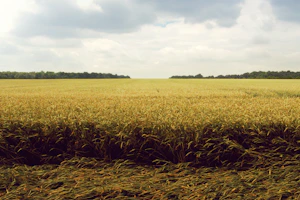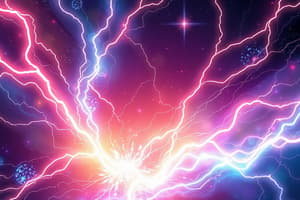Podcast
Questions and Answers
A student builds an electromagnet by wrapping a wire around an iron nail and connecting the wire to a battery. Which action would most effectively increase the strength of the electromagnet's magnetic field?
A student builds an electromagnet by wrapping a wire around an iron nail and connecting the wire to a battery. Which action would most effectively increase the strength of the electromagnet's magnetic field?
- Reducing the voltage of the battery while keeping the number of wire turns constant.
- Decreasing the number of turns of wire around the nail while maintaining the same current.
- Replacing the iron nail with a plastic rod.
- Increasing the number of turns of wire around the nail and increasing the current. (correct)
A generator uses which principle of electromagnetism to produce electricity?
A generator uses which principle of electromagnetism to produce electricity?
- A changing magnetic field can induce an electric current. (correct)
- A moving electric charge always experiences a force parallel to its motion in a magnetic field.
- A constant electric field creates a static magnetic field.
- The resistance of a conductor is directly proportional to the applied voltage.
In a simple circuit with a constant voltage source, if the resistance is doubled, what happens to the current, according to Ohm's Law?
In a simple circuit with a constant voltage source, if the resistance is doubled, what happens to the current, according to Ohm's Law?
- The current quadruples.
- The current doubles.
- The current is halved. (correct)
- The current remains the same.
Which of the following materials is the best insulator for preventing the flow of electric current?
Which of the following materials is the best insulator for preventing the flow of electric current?
How do magnetic field lines represent the magnetic field around a magnet?
How do magnetic field lines represent the magnetic field around a magnet?
A neutral object becomes positively charged. Which of the following explains what happened?
A neutral object becomes positively charged. Which of the following explains what happened?
Two charged objects are separated by a distance r. If the distance is doubled, how does the electric force between them change?
Two charged objects are separated by a distance r. If the distance is doubled, how does the electric force between them change?
Which of the following statements accurately describes the conservation of charge?
Which of the following statements accurately describes the conservation of charge?
Why do magnets attract certain metals, such as iron?
Why do magnets attract certain metals, such as iron?
The electric potential difference between two points is 12V. How much work is required to move a charge of 2C between these points?
The electric potential difference between two points is 12V. How much work is required to move a charge of 2C between these points?
A balloon rubbed against hair becomes negatively charged. What happened at the atomic level?
A balloon rubbed against hair becomes negatively charged. What happened at the atomic level?
Which of the following is the correct formula for calculating the electric force between two charges, according to Coulomb's Law?
Which of the following is the correct formula for calculating the electric force between two charges, according to Coulomb's Law?
If a material is easily magnetized, what can be inferred about its magnetic domains?
If a material is easily magnetized, what can be inferred about its magnetic domains?
Flashcards
Electrostatics
Electrostatics
The study of electric charges that are not in motion.
Electric Charge
Electric Charge
A fundamental property of matter that can be positive or negative.
Conservation of Charge
Conservation of Charge
The principle that total electric charge in an isolated system remains constant.
Coulomb's Law
Coulomb's Law
Signup and view all the flashcards
Electric Field
Electric Field
Signup and view all the flashcards
Electric Potential
Electric Potential
Signup and view all the flashcards
Electric Potential Difference
Electric Potential Difference
Signup and view all the flashcards
Magnetic Domain
Magnetic Domain
Signup and view all the flashcards
Magnetic Field
Magnetic Field
Signup and view all the flashcards
Electromagnet
Electromagnet
Signup and view all the flashcards
Electric Current
Electric Current
Signup and view all the flashcards
Conductors
Conductors
Signup and view all the flashcards
Ohm's Law
Ohm's Law
Signup and view all the flashcards
Study Notes
- Static electricity involves non-moving electric charges.
Electric Charge
- Charge is carried by tiny particles and can be positive (+) or negative (-).
- Charge is measured in Coulombs (C).
- Electrons have a negative charge, and protons have a positive charge.
- Opposite charges attract, while like charges repel.
- The process of rubbing a balloon on hair separates charges, transferring electrons from hair to the balloon.
- Electric charge is conserved, meaning it can neither be created nor destroyed but only transferred.
Coulomb's Law
- Determines the force between two charges.
- Formula: F = k * (q1 * q2) / r^2
- F: Force in Newtons (N)
- k: Coulomb's constant (approximately 8.99 x 10^9 N⋅m^2/C^2)
- q1 and q2: Magnitude of charges in Coulombs (C)
- r: Distance between charges in meters (m)
Electric Fields
- A charged object creates an electric field around it.
- Electric fields exert force on other charged objects.
- Measured in Newtons per Coulomb (N/C).
Electric Potential
- Represents the potential energy of a charged particle in an electric field.
- Measured in Volts (V).
Electric Potential Difference
- The difference in electric potential between two points.
- Causes charges to move.
- Measured in Volts (V).
Magnetism
- Magnets attract certain metals like iron, possessing a north and south pole.
- Magnetic Domain: Regions inside a magnet align in the same direction.
Magnetic Field
- Magnets create magnetic fields, depicted by lines from north to south pole.
Electromagnet
- A magnet created by electric current flowing through a wire.
- Strength is proportional to the current.
Electric Current
- The flow of electric charge, measured in Amperes (A).
Electromagnetism
- Moving charges create magnetic fields, and changing magnetic fields can create electric currents.
- Generators use this principle to create electricity, and motors use it to create motion.
Key Ideas for NY Physics 1 Regents
- Conductors allow charges to flow easily, while insulators do not.
- Electric field lines and magnetic field lines can be drawn to represent these fields.
- Ohm's Law (V = IR) describes the relationship between voltage (V), current (I), and resistance (R).
- Be familiar with the basic parts of a circuit.
Studying That Suits You
Use AI to generate personalized quizzes and flashcards to suit your learning preferences.
Description
Explore static electricity, electric charge, and Coulomb's Law. Learn about the forces between charges and electric fields. Understand charge conservation and electric field measurement.




